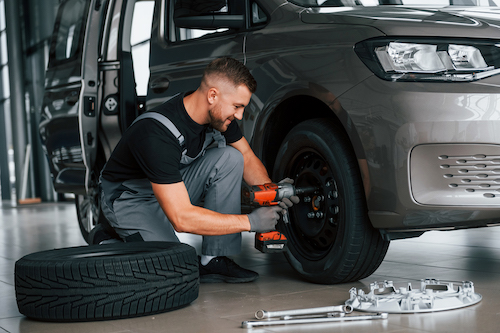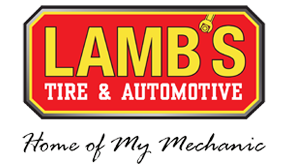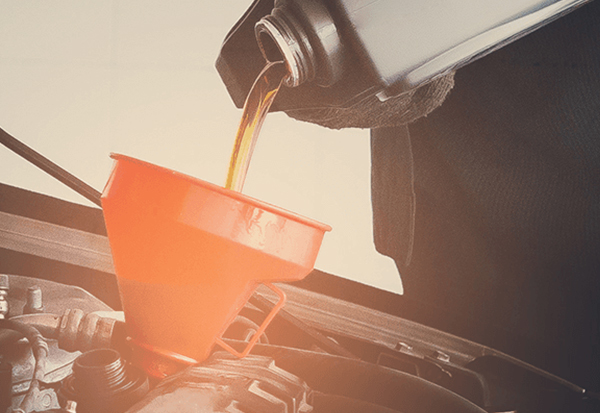Tire Repair: What Type of Service Do I Need?

It’s usually not hard to tell when you need tire repair or maintenance work in Austin, TX. Like other auto repair issues, tire problems can cause all kinds of symptoms, ranging from uneven tire wear to reduced fuel efficiency. Of course, knowing what services your vehicle may need is another story.
Different tire services are available that can help keep your tires in tip-top shape, but understanding the difference between these jobs can be difficult even for the most knowledgeable Austin drivers. Whether you’ve had your tires repaired dozens of times or don’t know the difference between “tire balancing” and “tire rotation,” keep reading for our comprehensive guide to tire maintenance and repair services.
Understand These Tire Repair and Maintenance Services
Any Austin-area auto repair shop worth its salt will be able to patch a flat tire. That said, the region’s best tire shops will go above and beyond by caring for your tires even when they haven’t experienced severe damage. When you’re searching for a tire shop, make sure its mechanics can handle services such as:
Tire Repair in Austin
Noticing that your tire has suddenly gone flat or experienced severe damage can be alarming, but this doesn’t always mean you have to replace your tire right away. In many cases, a quick tire repair will be all you need to get back on the road. If you’re unsure whether or not you can safely repair your tires, don’t worry — you’ll have a chance to learn more in a bit.
Tire Balancing
A good set of tires will match in every possible way, including their weight. But no matter how identical your tires are when they’re new, the process of normal wear can be enough to change how much they weigh. Consequently, there’s a good chance that your tires won’t all weigh the same for long, and that can lead to uneven tire wear, steering wheel vibrations, and other issues.
The simplest, most effective way to fix this problem is to visit a local auto mechanic for tire balancing work. This auto service focuses on removing your car’s tires from their axles, carefully weighing each, and then adding small weights to any tires that weigh less than they should. When this process is complete, your wheels will be back in balance.
Tire Rotation
The position of your tires on the axle can affect their wear pattern. This is the case because driven wheels work harder than non-driven wheels do. As you might assume, tires dealing with this increased level of demand wear out more quickly.
Fortunately, there’s an easy way to stop this from becoming an issue. All you have to do is to visit an auto shop every so often to get your tires moved to different locations on your vehicle. This work, known as “tire rotation,” should always be handled by professional mechanics. Tires can be rotated in several different patterns, something that qualified technicians will be able to keep track of for you.
Tire Alignment
Have you ever thought about the angle of your car’s tires? Even if your wheels are misaligned by a single degree, you’ll immediately notice the consequences. In this situation, you could suffer from lower fuel efficiency, find it all but impossible to steer correctly, and eventually contend with uneven tire wear.
Technically, tire alignment doesn’t involve work on your tires at all — instead, the point of this service is to make adjustments to your suspension. Since that system connects your wheels to the rest of your vehicle, adjusting it changes the angle at which your tires contact the road. Those adjustments can dramatically affect how your tires perform and wear.
TPMS Work
Your vehicle’s tire pressure monitoring system (TPMS) monitors your wheels’ rotational speed or air pressure. Underinflation is the single most common cause of tire failure, so if you have any reason to suspect your TPMS isn’t working correctly, you should have this system looked at by the experts.
Tire Repair or Replacement: Which Option Is Right for You?
In many cases, finding an auto mechanic to perform one of the tire repair or maintenance services listed above will give your tires a new lease on life. Still, most tires have a service life of three to five years. If your tires are old enough or have been badly damaged, they should be replaced instead.
Consult this guide to know whether you need tire repair or replacement when your wheels have experienced:
Accident Damage
Car crashes can affect every component in your vehicle, and your tires certainly aren’t immune. Tires with their treads separated or cut in a collision need to be replaced immediately.
Aging
As most responsible Austin drivers know, proper tire maintenance will go a long way toward helping your tires reach their maximum lifespan. But no matter how attentive you are, your wheels won’t last forever.
As the age of your tires increases, their tread depth decreases. To check this, place a penny into your treads with President Lincoln’s head facing down — if you can still see the top of his head, you’re ready to shop for new tires.
Tire pressure problems are another sign that your wheels are getting old. Once your wheels lose more than one pound of pressure per square inch monthly, you should make a point of replacing them.
Bubbling
Bubbles can develop in the sidewall of a tire due to multiple factors, such as traveling on a flat tire, hitting railroad tracks or speed bumps while driving quickly, running into potholes or curbs, and traveling with heavy loads. In any case, you should take this type of damage seriously. Even the best mechanics can’t fix tire bubbles, and they could cause a blowout if you ignore them.
Damage on Multiple Occasions
Believe it or not, tires that have been damaged more than once can still be fixed. However, there are some restrictions to consider: most notably, damage that overlaps with pre-existing damage is irreparable. But if there’s no overlap, you might be able to get your tires repaired.
Puncture Damage
Has one of your tires been punctured? You could be able to fix it, assuming the diameter of its puncture isn’t larger than a quarter-inch. However, holes in a tire’s sidewall or shoulder are not repairable.
Sometimes, even tires with more than one hole can be repaired. For that to be an option, your tire can have no more than two holes, which must be separated by at least 16 inches. When you have three or more punctures or punctures that are too close together, you will have to get a tire replacement instead.
Get Tire Repair at Austin’s Top Auto Repair Shop
Whenever you need tire repair, maintenance, or replacement, you should carefully consider where you’ll get these services performed. After all, your tires are arguably the most important component in your vehicle. Before you schedule one of these types of auto service, take some time to find a genuinely excellent auto repair shop to handle it.
Ideally, your Austin tire shop should employ ASE-certified mechanics, provide at least a few locations in the area, and give its customers opportunities to save by offering online coupons. If you want these benefits and more, give Lamb’s Tire & Automotive a try.
For over 30 years, we’ve been Austin’s go-to auto shop — find out why by booking an appointment for tire service today!









